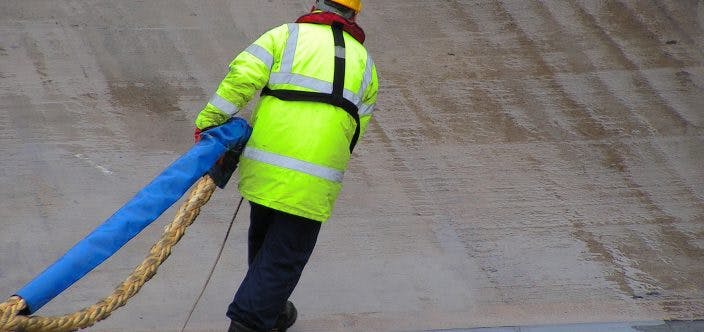Occupational Safety – Cargo operations on Ro-Ro/Ro-Pax vessels
This article is based on what was said during Alandia's Lessons learned webinar in Occupational Safety. You can watch the full recording of the webinar below.
Why is it important to address this topic?
Cargo handling is a very high-risk operation with real risk for fatal accidents. The more intensive the sailing schedule and the shorter the turnaround time, the more frequently near misses and incidents are observed. Apart from maintaining schedule the cargo needs to be loaded and secured safely onboard in order toto ensure a safe sea voyage and an efficient discharging. Today’s RO-RO vessels often carry complex and heavy cargoes. Due to this complexity, preparing the cargo for safe transport to the end destination may seem overwhelming to many new clients.
“New different kinds of clients is now setting up factories in different parts of the world, and this triggers the need for transportation of items that have not been carried in that extent before … We get a lot of more questions from clients that is not used to how the cargo should be prepared to safely be carried onboard RO-RO vessels.”
Einar Bassoe, Höegh Autoliners
In addition to the growing number of new clients, we have also seen an increase in the stevedoring accidents, since machinery is more and more often operated without the necessary skills.
The discussion about fires in the lithium batteries of electric cars has gone on for a while, but there are also other safety issues with electric cars in the loading process that should be paid attention to. There is a potential danger in electric vehicles because they are so quiet that the loading personnel can’t hear them. If they don’t see a car moving, they might not realize that it is approaching. Another issue that has surfaced is that electric car drivers often ignore the speed limit on the deck because the torque is immediate and you don’t have to shift gears, so they accelerate very fast while driving onboard.
The time in port and turnaround times for a vessel have become dramatically shorter while vessel sizes have increased. In spite of these developments, loading is more efficient than before, since it is now possible to load and discharge simultaneously. However, this means that there is a lot more traffic on the stern ramp during loading and discharging operations, which increases the risk of accidents.
Why is commercial pressure problematic and what to do about it?
“RO-PAX operations where we depart on a fixed schedule with hours and minutes pinpointed, is a dangerous thing that we really need to address constantly – the perceived commercial pressure”
Mikael Lindgren, Stena Line
Since the launching of the International Safety Management Code (ISM), the discussions around commercial pressure and safety culture have been prioritised.
In order to safely tackle work under prevailing commercial pressure, the leadership onboard the vessel needs to feel unconditionally supported by the shore organisation regarding actions for a safer operation. The dialogue regarding commercial pressure needs to be continuous and initiated through a top-down structure; from the person on top of the company’s safety organisation to the vessel command and ultimately to the crew handling the cargo. The crew needs to be encouraged to speak up if something in the cargo operation is not working according to procedure, and if the rest hours are not met etc.
It is important that the decision to reject cargo is taken before the cargo enters the stern ramp, since that is the last line of defence. If the cargo is to be vetted and rejected onboard, it can cause unreasonable commercial pressure on the vessel crew taking the decision to accept or reject cargo.
Since the start of the covid-19 pandemic, cargo volumes have increased a great deal. From a safety point of view, this sets tremendous challenges for loading and discharging. Cargo handling onboard is hectic, with short time spans for loading and discharging high volumes of Ro-Ro cargo. This may cause a problem with the rest hours that lead to less crew available on cargo decks.
Another issue during the pandemic is the crew changes. The pandemic has created a commercial understanding for vessels that need to change crew in another port or that have delays because of rest hours not otherwise being met. Crew members’ mental health issues due to problematic crew changes have been a major threat to safety in cargo operations.
“We have had huge problems with crew changes, and this has affected safety on deck … The regulations in each country have changed continuously, so it has been very uncertain when the crew is coming home and of course this has affected the safety on deck”
Anders Nylander, Wallenius Marine
How to make sure the shipping companies are taking steps to learn about and develop safety?
A good trend from a regulatory point of view is that training has become more structured. This gives shipping companies the opportunity to train the crew in how to create and develop safe procedures on cargo decks during loading and discharging.
To make sure new crew members learn how to work safely during cargo operations:
- Assign them a mentor/training buddy who is familiar with the vessel and its cargo operations
- The instruction and familiarisation documents need to be clear and simple
- The most important thing for learning are the hands-on instructions issued by the experienced crew
- Have more people on the same task: besides those who are required to get the task done, have one crew member to supervise and stand by to help with the task, while the new crew member is trying to learn the task(s).
Internal audits are important opportunities to regularly verify whether the procedures and instructions are being followed and working.
Briefing in cargo operations is not just necessary for the crew; everybody participating in the operation should be trained and familiarized with the procedures. One important routine is to have clear signs between the crew and the stevedores for when cargo is to be driven and when it is to be stopped. The plans and procedures regarding cargo operations should always be clarified between the crew and the stevedoring company/foreman.
“What we have focused on a lot in the last years is the vetting on the stevedoring companies, training the stevedores and ourselves … and we have also had a lot of focus on signalmen’s blind spots and it’s for sure that … blind spots make it difficult for drivers and signalmen to see the personnel as well”
Filip Svensson, Wallenius Wilhelmsen Logistics
During cargo operations, blind spots are a common source of incidents and accidents. Unprotected seafarers need to be in clear view of those who operate the machinery. To make sure that there are no blind spots when loading, it is important to train effective and attentive communication to make sure everyone involved is aware of their surroundings.
How does the reporting of near misses work during a cargo operation?
Still not enough near misses are reported. This is a problem in the whole shipping industry. One possible reason for too few reports coming in is that it is time consuming to make the report, and the reporting tools are stashed away from the actual cargo operation e.g., in an office onboard. Directly after something happens, one action is to have a debriefing with the crew and the stevedores – what went wrong and how can we prevent it from happening again?
Tools commonly used for making near miss reports include the companies’ intranet, the Planned Maintenance System (PMS) or an app via iPad or a smart phone. The threshold for reporting should be low and included in the company’s safety culture. When receiving the reports, it is important to confirm that the report has been received and to analyse the current trends and events in order to recognise what is going on and what needs to be improved, prevented, and amended.


